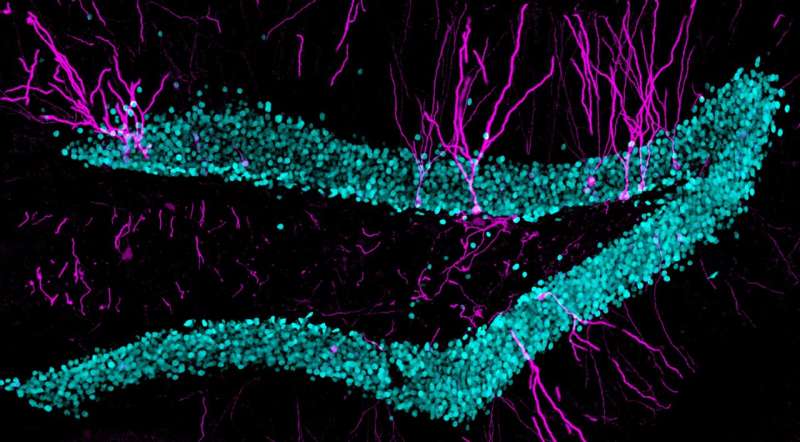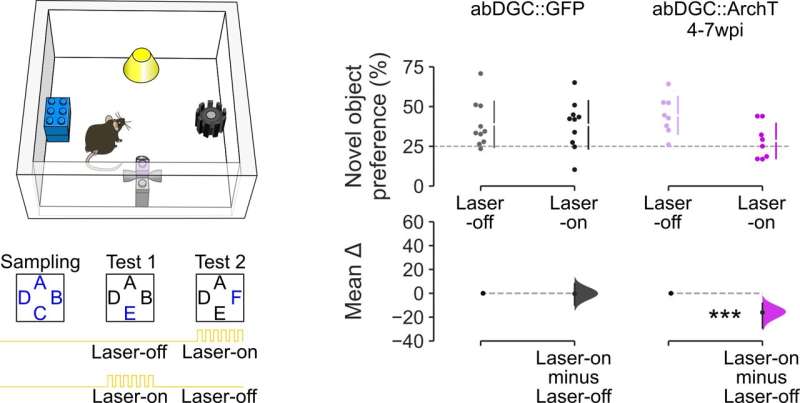November 3, 2022 feature
Adult-born dentate granule cells support the activity of hippocampal cell populations

The dentate gyrus (DG) is a region of the mammalian brain known to support the encoding of new memories. This brain region is part of the hippocampal formation, a set of brain regions involved in vital memory functions.
Past neuroscience studies showed that throughout a mammal's lifespan, the DG produces cells that regulate the flow of information into the hippocampus, known as adult-born dentate granule cells (abDGCs). Despite the extensive research investigating the role of these cells, their contribution to downstream firing dynamics (i.e., the neuronal responses that they initiate) remains poorly understood.
Researchers in the MRC Brain Network Dynamics Unit at University of Oxford have recently carried out a study investigating how abDGCs contribute to the function and activity of neurons in the hippocampus, a brain area central to learning and memory. Their findings, published in Nature Neuroscience, suggest that abDGCs modulate the spiking of neuron populations in the hippocampus during the processing of new stimuli and their encoding as memories.
"Despite many previous investigations into the function of adult-born dentate granule cells, their contribution to population activity patterns in behaving animals has remained elusive," Stephen B. McHugh, one of the researchers who carried out the study, told Medical Xpress. "We wanted to determine what happens to other hippocampal neurons when you activate or silence abDGCs, i.e., to discover how they influence whole-hippocampal network activity."
McHugh and his colleagues carried out their experiments on adult mice. They targeted the mice's abDGCs using optogenetics, strategies to control the activity of these neurons using light and genetic engineering techniques. They specifically targeted the cells using light-sensitive proteins, which allowed them to optically tag them and manipulate their activity.

"Simultaneously, we recorded neuronal activity from three hippocampal regions—dentate gyrus, CA3 and CA1—as mice explored familiar and novel environments," McHugh explained. "We also recorded neuronal activity and behavior during a novel object recognition task to determine if silencing abDGCs affected novelty preference."
The experiments conducted by McHugh and his colleagues yielded very interesting results. Most notably, the researchers found that abDGCs in the adult mice's brains had higher firing rates, particularly when the mice were exploring new environments. Nonetheless, these cells appeared to carry less spatial information than other hippocampal neurons, suggesting that they are less likely to be so-called "place cells" (i.e., neurons that fire when an animal is exploring specific regions of their environment) than other neurons in the hippocampus.
"Essentially, we observed that while mature granule cells are like quiet introverts, abDGCs are like noisy extroverts," McHugh said. "Second, we found that abDGCs are more rhythmic in their firing (more coupled to theta oscillations), and their firing drives activity in other hippocampal neurons, particularly interneurons which inhibit firing in excitatory neurons."
Interestingly, the researchers' findings suggest that abDGCs influence the proportion of simultaneously active neurons at a given point in time across the hippocampus (i.e., how sparse the ongoing hippocampal population activity is). This effect appears to be bi-directional, which means that when abDGCs are activated the sparsity of hippocampal population activity is increased, and when they are silenced, it is reduced.
"This loss of sparsity has consequences for memory, because silencing abDGCs impairs object novelty-preference," McHugh added. "Sparse population activity thus seems to be a key feature of effective hippocampal 'neuronal processing' and loss of sparsity may underlie memory problems in conditions such as Alzheimer's disease, which has been found to be associated with decreased numbers of abDGCs."
In the future, the findings gathered by this team of researchers could pave the way for more studies investigating the influence of abDGCs on the sparsity of hippocampal population activity. This could lead to new important discoveries about the role of abDGCs in promoting healthy memory encoding and retrieval, which could in turn help to better understand conditions associated with memory impairments.
More information: Stephen B. McHugh et al, Adult-born dentate granule cells promote hippocampal population sparsity, Nature Neuroscience (2022). DOI: 10.1038/s41593-022-01176-5
Yi Zhou et al, Molecular landscapes of human hippocampal immature neurons across lifespan, Nature (2022). DOI: 10.1038/s41586-022-04912-w
© 2022 Science X Network




















